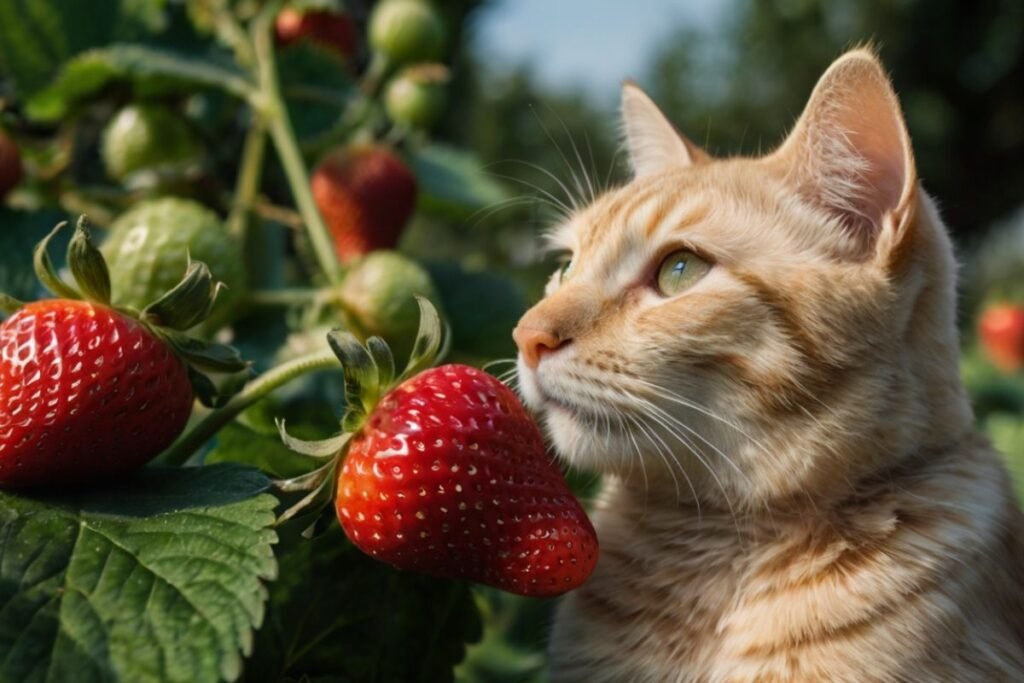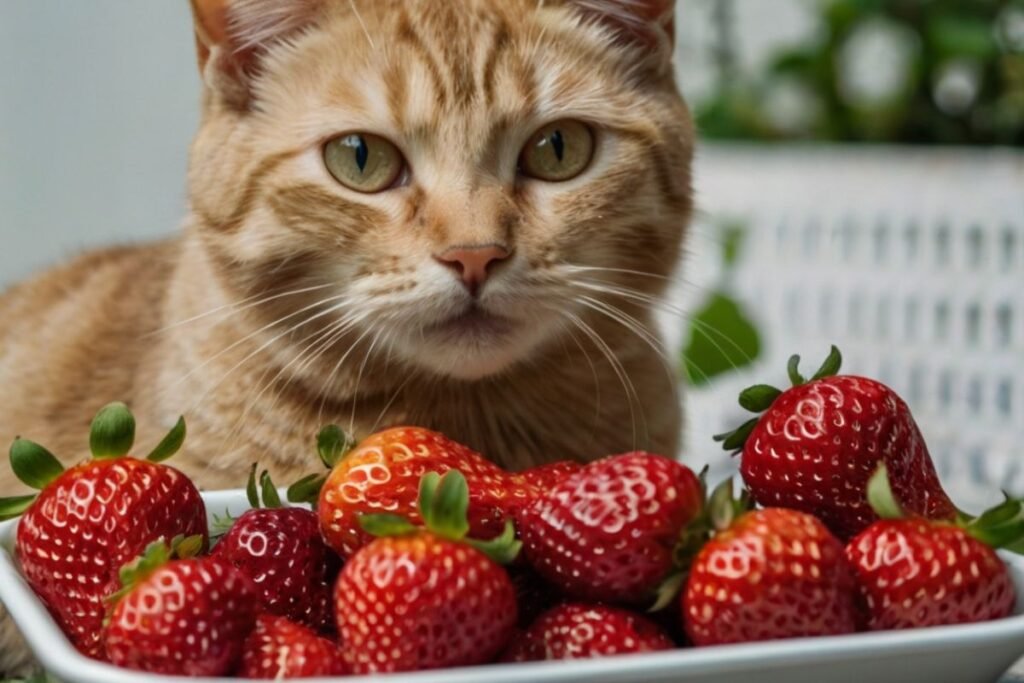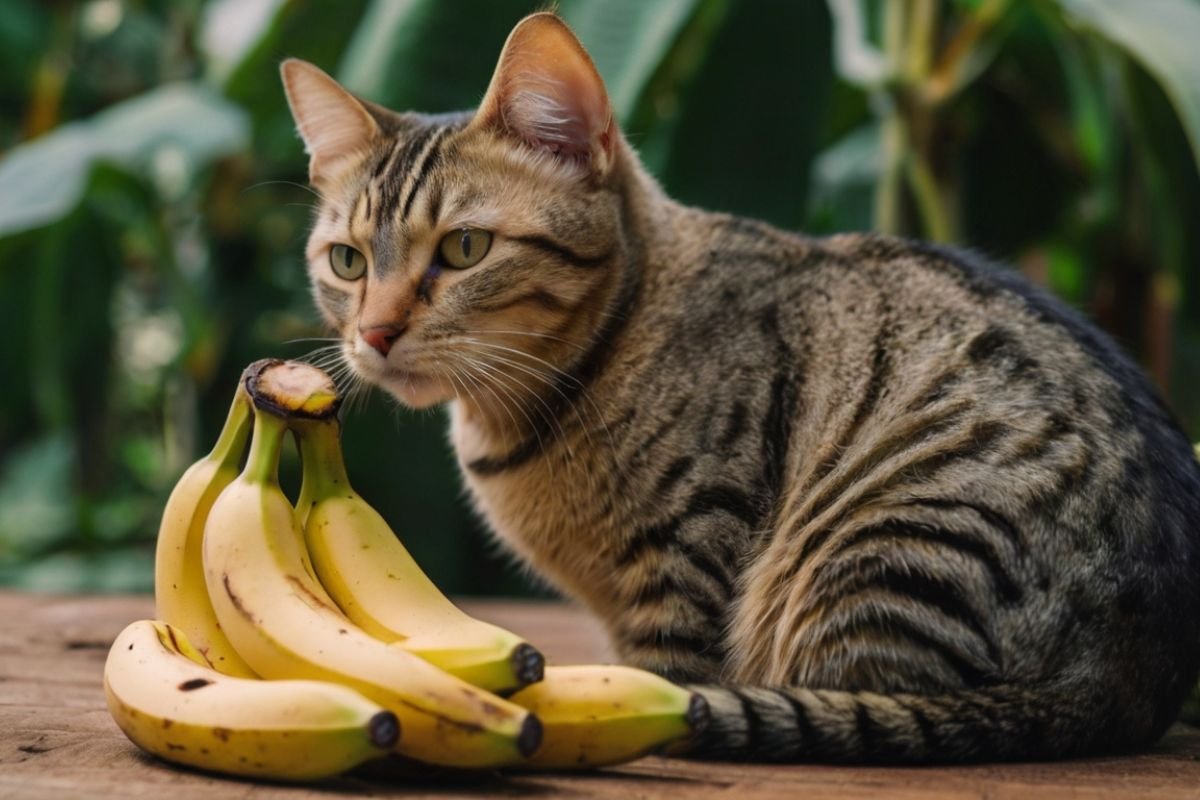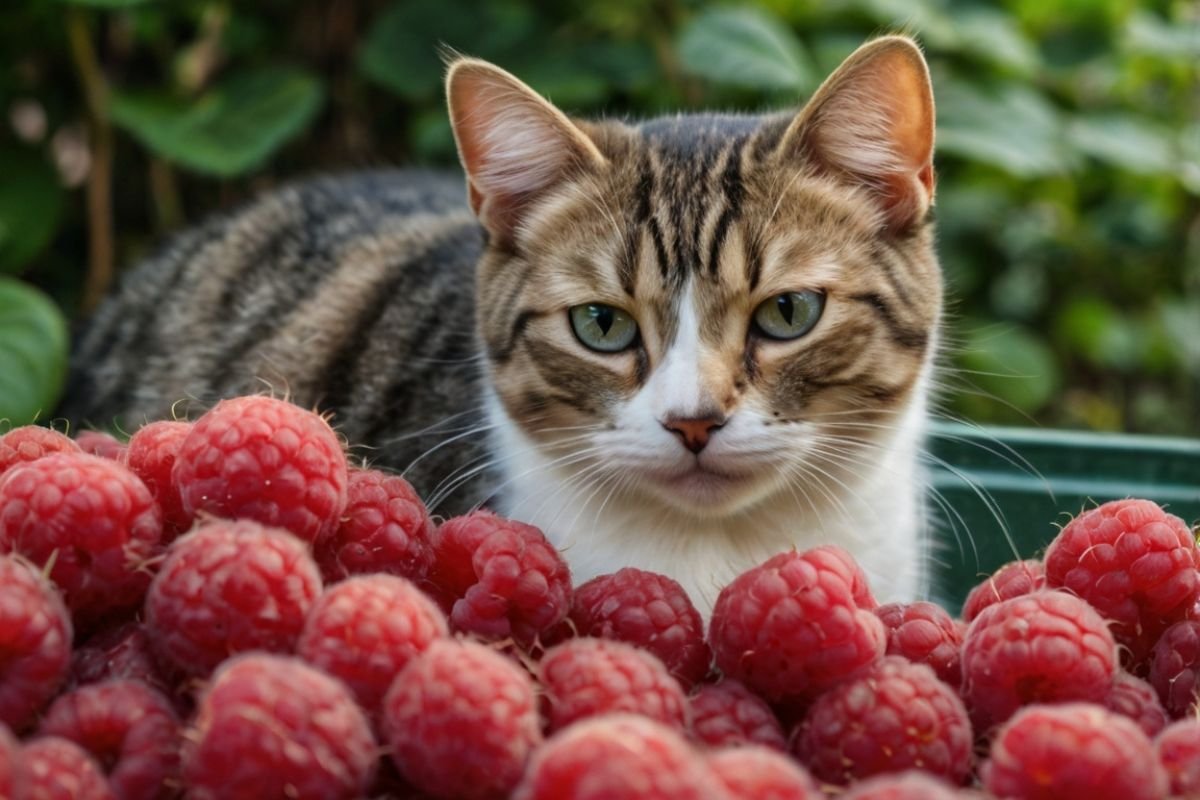Cats and strawberries – an odd pair at first glance. My orange tabby Rio once sniffed a strawberry with such curiosity that it got me wondering. Can our feline friends safely enjoy this sweet treat? Let’s dive into everything you need to know about cats and strawberries.

Table of Contents
Are Strawberries Safe for Cats?
The short answer is yes. Cats can eat strawberries. They are not toxic to cats. This is good news if your cat shows interest in this red fruit.
Unlike grapes or raisins, strawberries pose no poison risk to your cat. The ASPCA lists strawberries as non-toxic to cats. This means you don’t need to panic if your cat takes a nibble.
But being safe doesn’t mean it’s ideal. Cats are meat eaters at heart. Their bodies work best with animal proteins. Plants and fruits don’t meet their main food needs.
Think of strawberries for cats like candy for people. It’s okay as a tiny treat now and then. It should never replace real cat food.
Rio once licked a strawberry I was cutting. He didn’t seem too thrilled. This makes sense given cats lack sweet taste buds. Still, some cats do show interest in strawberries. Each cat has its own likes.
Also read, Can Cats Eat Watermelon?
The Nutritional Value of Strawberries
Strawberries pack lots of good stuff in a small package. They have:
- Vitamin C
- Fiber
- Water
- Antioxidants
- Folate
- Potassium
- Manganese
These bright berries rank high in vitamin C. They also contain fiber that aids digestion. The water in strawberries helps with hydration too.
The antioxidants in strawberries fight cell damage. They may help reduce cancer risks. These small fruits also have less sugar than many other fruits.
But do cats need these nutrients from strawberries? Not really. Cats get most of what they need from meat-based diets. Their bodies make vitamin C on their own, unlike humans.
While the nutrients in strawberries are good, cats don’t process plant foods as well as we do. Their short gut lacks certain enzymes. This means they gain less from fruits than humans do.
Potential Benefits of Strawberries for Cats
Though not needed, strawberries might offer some perks for cats in tiny amounts.
The high water content can help with hydration. This matters since many cats don’t drink enough water. The fiber may aid cats with mild constipation. Antioxidants could support overall health.
The low calorie count makes strawberries a better treat option than many store-bought cat treats. This helps if your cat needs to lose weight.
Rio tends to get a bit chunky, so I’m always on the lookout for low-calorie treat options. Though he’s not a strawberry fan, the concept is sound.
Some cats might enjoy the texture of strawberries. The smell or feel might give them joy. Mental stimulation from new foods has value too.
Just keep in mind that any benefits come from very small amounts. Strawberries should make up less than 2% of your cat’s diet.
Potential Risks of Strawberries for Cats
While strawberries aren’t toxic, they do come with some risks worth knowing.
Sugar content poses the main issue. Cats don’t need fruit sugars. Too much can lead to:
- Weight gain
- Dental issues
- Upset stomach
- Diarrhea
Cats with diabetes should avoid strawberries entirely. The natural sugars could affect blood sugar levels.
The fiber in strawberries, while good in small amounts, might cause problems in larger servings. Too much fiber can lead to gas, bloating, or diarrhea in cats.
Allergic reactions are rare but possible. Signs might include:
- Itchy skin
- Ear scratching
- Sneezing
- Vomiting
- Face swelling
If you notice these signs after your cat eats strawberries, stop giving them and call your vet.
Strawberry leaves and stems are not toxic but can be hard to digest. They could cause choking or gut blockage in some cases.
Pesticides pose another risk. Many farms use strong chemicals on strawberries. Always wash berries well or pick organic ones to reduce this risk.
How to Safely Introduce Strawberries to Your Cat
If you want to try giving your cat strawberries, follow these steps:
- Talk to your vet first, especially if your cat has health issues
- Buy fresh, ripe strawberries (organic if possible)
- Wash the strawberries very well under running water
- Remove the leaves, stem, and seeds
- Cut the strawberry into tiny, pea-sized pieces
- Offer just one small piece at first
- Watch your cat for 24 hours for any bad reactions
- If all goes well, you can offer small amounts on rare occasions
When I first thought about letting Rio try new foods, I made sure to follow these steps. Starting small is key with any new food.
Never force your cat to eat strawberries. If they show no interest, that’s perfectly fine. Most cats don’t crave fruits since they can’t taste sweet things.
How Much Strawberry Can a Cat Eat?
Very little. A few small pieces make a good limit. Think of a strawberry cut into 8-10 pieces. One or two of those pieces is plenty for a cat.
Treats overall should make up no more than 10% of your cat’s daily calories. Strawberries should be an even smaller part of that 10%.
For a medium-sized cat, this means just a teaspoon or less of strawberry. Any more risks upset stomach or other issues.
Space out these treats. Don’t give strawberries daily. Once a week or less keeps it special without causing problems.
Alternative Fruits and Treats for Cats
If your cat doesn’t like strawberries or you want options, consider these cat-safe fruits in tiny amounts:
- Blueberries (even lower in sugar)
- Watermelon (without seeds)
- Cantaloupe (many cats enjoy this)
- Apple (no seeds, core, or skin)
- Banana (very small amounts)
Rio particularly enjoys small bits of watermelon on hot days. It helps keep him hydrated while giving him a novel texture to explore.
Remember that even these safe fruits should be rare treats. Meat-based treats often make better options for cats. Their bodies use animal proteins more easily.
Commercial cat treats designed for dental health might give more benefits than fruit. Talk to your vet about the best treats for your cat’s needs.
Why Some Cats Are Attracted to Strawberries
It’s odd that some cats show interest in strawberries when they can’t taste sweet. The reason likely lies beyond taste.
Cats have a strong sense of smell. The scent of strawberries might intrigue them. Some cats may be drawn to the smell of certain compounds in strawberries.
Texture plays a role too. The unique feel of strawberries might appeal to cats. The moisture or flesh of the fruit offers a new sensory experience.
Curiosity drives many cat behaviors. They might show interest in what you’re eating simply because you seem to enjoy it. Cats often want to investigate anything their humans find interesting.
Some cats may enjoy the cooling effect of cold strawberries, especially on warm days. The slight crunch might also provide enrichment.
Common Myths About Cats and Strawberries
Several myths about cats and strawberries need clearing up:
Myth 1: Cats need fruits for vitamins. Truth: Cats get their needed vitamins from meat-based diets. Their bodies don’t require plant-sourced vitamins.
Myth 2: Strawberries can replace cat foods. Truth: Strawberries lack the proteins and taurine cats need. They cannot replace proper cat food.
Myth 3: If a cat likes strawberries, they can eat as many as they want. Truth: Even if your cat loves strawberries, they should only have tiny amounts rarely.
Myth 4: Strawberry-flavored products are fine for cats. Truth: Artificial strawberry flavors often contain xylitol or other harmful ingredients. Stick to fresh strawberries only.
Myth 5: Wild cats eat fruits, so house cats should too. Truth: Wild cats eat primarily meat. They only consume plant matter in the stomachs of prey or in times of food scarcity.
Signs Your Cat May Have Eaten Too Many Strawberries
If your cat gets into strawberries without your knowledge, watch for these signs:
- Vomiting
- Loose stools or diarrhea
- Lethargy
- Loss of appetite
- Excessive thirst
- Gas or bloating
- Signs of pain
Most cases of strawberry overindulgence cause mild and short-lived symptoms. Still, it’s best to call your vet if you notice these signs, especially if they last more than a day.
If your cat shows more severe signs like difficulty breathing or collapse, seek emergency vet care right away. While rare, allergic reactions need prompt treatment.
The Science Behind Cats and Plant Foods
Cats’ bodies tell us a lot about what they should eat. As obligate carnivores, they have evolved to eat meat.
Their teeth show this meat focus. They lack flat molars for grinding plants. Instead, they have sharp teeth meant for tearing meat.
Their digestive system is short and simple. It’s made to process animal proteins fast. Plant matter needs longer digestive tracks and special enzymes that cats lack.
Cats can’t make certain amino acids like taurine on their own. They must get these from animal tissues. No plant food provides enough taurine for cats.
The lack of sweet taste buds also points to their meat diet. Unlike omnivores who benefit from finding sweet (often safe) foods, cats evolved without this need.
Their liver enzymes work differently too. Cats process some plant compounds poorly. This is why certain plants safe for humans can harm cats.
All this science confirms that while small amounts of some plant foods won’t harm cats, they gain little benefit from them.
What Veterinarians Say About Cats and Strawberries
Most vets take a moderate view on cats and strawberries. They agree that strawberries aren’t toxic but aren’t necessary either.
Dr. Gary Richter, a holistic veterinarian, notes that small amounts of berries can provide antioxidants. However, he stresses they should make up a tiny fraction of the diet.
The Cornell Feline Health Center reminds cat owners that treats should make up less than 10% of a cat’s daily calories. Within that small amount, meat-based treats often provide more benefits than fruits.
Veterinary nutritionists point out that commercial cat foods already contain all the nutrients cats need. Adding strawberries doesn’t fill any nutritional gaps.
Many vets suggest that if you want to give your cat strawberries, use them as an occasional novel experience rather than a health food.
I asked my vet about Rio trying strawberries. She said it was fine as an occasional tiny treat but reminded me that his complete cat food already meets all his needs.
A Personal Touch: My Experience with Cats and Berries
While Rio didn’t care much for strawberries, I’ve noticed how each cat has unique food preferences. Some cats do seem drawn to certain fruits.
I once fostered a cat who would come running at the sound of blueberries being poured into a bowl. She never showed that interest in strawberries.
What I’ve learned through years of cat care is that variety and enrichment matter. New textures, smells, and experiences can make a cat’s life richer. Sometimes a tiny bit of fruit can provide that novelty.
The key is knowing each cat’s limits and needs. What works for one cat might not work for another. Always watch how your individual cat responds to new foods.
Preparing Strawberries for Your Cat: Step by Step
If you decide to offer strawberries to your cat, follow this detailed process:
- Choose firm, ripe strawberries with good color
- Rinse thoroughly under cool running water for at least 30 seconds
- Rub gently with fingers to remove any residue
- Pat dry with a clean paper towel
- Cut off the leafy top and the white core
- Slice the strawberry in half
- Remove any visible seeds if possible
- Cut into tiny pieces (smaller than pea-sized)
- Offer one piece at room temperature
- Store any unused pieces in the refrigerator for up to a day
These steps help reduce the risks and make the experience safer for your cat.
Alternatives to Fresh Strawberries

Fresh strawberries make the best option if your cat shows interest. But what about other forms?
Frozen strawberries: These can work if they contain no added sugar or other ingredients. The cold might appeal to some cats, especially in summer.
Freeze-dried strawberries: These concentrate sugars and may be too sweet. They also lack the hydration benefits of fresh berries.
Strawberry jam or jelly: Never give these to cats. They contain far too much sugar and often have additives.
Strawberry-flavored cat treats: These rarely contain real strawberries. Check labels carefully for artificial ingredients.
Strawberry plants: The leaves and stems aren’t toxic but may cause stomach upset if eaten in quantity.
When in doubt, stick with small amounts of fresh strawberries as the safest option.
Balancing Treats in Your Cat’s Diet
Treats play an important role in many cat-human relationships. They can strengthen bonds and provide enrichment. The key is balance.
Track all treats your cat gets, not just fruits. This includes commercial treats, human food scraps, and anything else beyond regular cat food.
Use a simple rule: if you give one type of treat, reduce others that day. This helps maintain the 10% treat limit.
Consider making treats special by using them during play or training. This adds value beyond just the taste.
If you have multiple family members, create a system to prevent double-treating. A treat chart or communication plan helps avoid overfeeding.
For cats with health issues like diabetes or kidney disease, work closely with your vet on a treat plan. Some cats need stricter limits than others.
Conclusion: Should Your Cat Eat Strawberries?
So, can cats eat strawberries? Yes, they can, in tiny amounts. Are strawberries good for cats? They’re neither particularly helpful nor harmful when given properly.
The decision to offer strawberries should consider your individual cat’s:
- Health status
- Weight
- Interest level
- Existing diet
- Vet’s recommendations
If your cat shows curiosity about strawberries, a tiny taste won’t hurt. Just keep portions very small and infrequent.
Remember that your cat’s main diet should focus on high-quality cat food that meets their carnivore needs. Treats like strawberries should remain just that – rare treats.
Watch your cat’s reaction to new foods closely. What works for one cat might not work for another. Rio’s disinterest in strawberries reminds us that cats have their own preferences!
The most important thing is your cat’s overall health and happiness. Whether that includes the occasional strawberry is up to you and your furry friend. Just keep it safe, keep it small, and keep it special.

Shahriar Robin is the creator of WhatPetsCanEat.com, a passionate pet lover and dedicated cat dad to Rio, a curious two-year-old orange feline who inspired this website. With a love for animals and a knack for research, Shahriar shares trusted, easy-to-understand information to help fellow pet owners make safe, healthy food choices for their furry friends.


